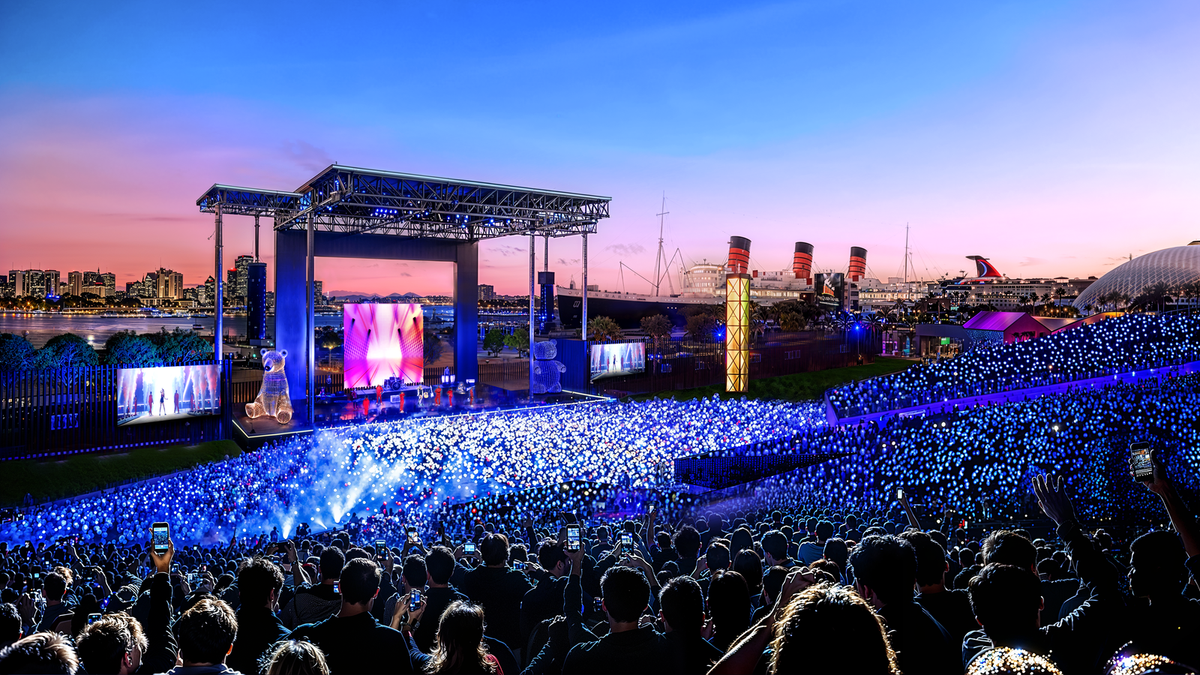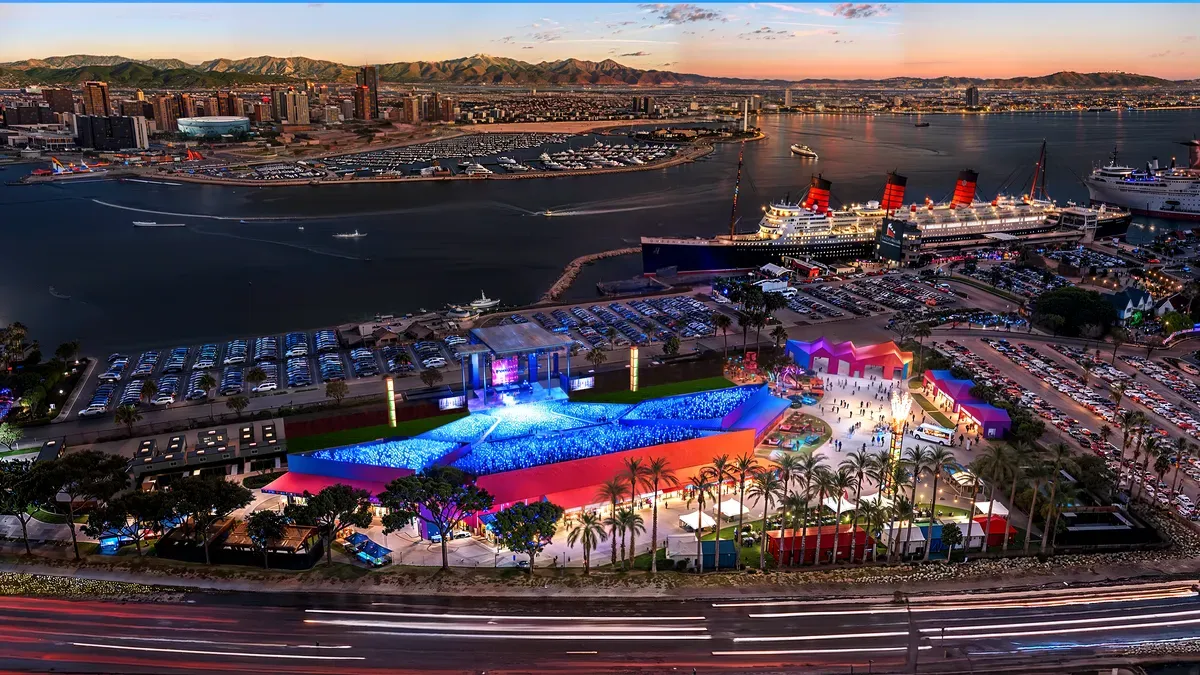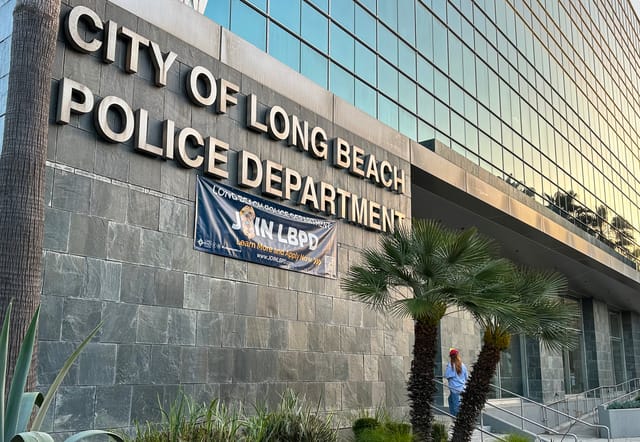How much does a seaside amphitheater cost? Long Beach officials say they don’t know yet
A temporary amphitheater is supposed to open adjacent to the Queen Mary this fall, but no timeline, budget or funding source has been finalized, according to city staff.

During his State of the City address earlier this month, Long Beach Mayor Rex Richardson waxed poetic about Long Beach’s “musical roots” and turning the city into the “coastal live music capital of the world.” To that end, the city is moving forward with plans to construct a temporary amphitheater next to the Queen Mary — but few details are actually concrete.
It’s been over a year since Richardson first announced his vision for a waterfront amphitheater and one week since he said the temporary facility would be “opening in the fall of this year.” The city, however, has few details to offer about a timeline, a budget or funding sources for the project.
“The preliminary budget is being developed along with the procurement and installation timelines,” city spokesperson Chelsey Magallon said in an email to the Watchdog Tuesday, one week after a list of questions was submitted.
Planning and permitting work is underway, according to Magallon, who added that asphalt and hardscape work will “begin shortly in the coming months.”
While the cost is unknown, Magallon said the current plan is to fund the amphitheater with “internal borrowing from available reserves,” which would then be repaid using proceeds from amphitheater operations. The City Council, though, will first have to approve any proposed budget or funding source.
Despite no firm opening date, Magallon said the city is “interested in both an inaugural event and the creation of a signature annual event.” Once open, Magallon said the amphitheater could host between 30 and 40 events each year, which is “consistent with similarly sized comparative venues.”
“This facility will become a centerpiece for live performances […], offering unforgettable experiences for residents and visitors while supporting our local small restaurants, shops and businesses who will benefit from increased foot-traffic before and after major concerts,” Richardson said during his remarks last week.
The city received six proposals from potential operators, though Magallon did not disclose what companies were vying for the job. In the end, staff selected ASM Global, which also manages the city-owned convention center, and its parent company Legends.
“We are excited about the privilege of being part of this incredible journey with the Long Beach community,” ASM Executive Vice President of Convention Centers Dan Hoffend said in a statement. “Long Beach has hosted some of the most iconic events in history, and we are focused on adding to that legacy by creating unforgettable moments that inspire and elevate this already amazing destination.”
Magallon emphasized that, while city staff selected the firms, negotiations are ongoing and will be presented to the City Council as a formal recommendation for approval on March 11.
The temporary venue is expected to have anywhere from 10,000 to 12,000 seats, with the final count to be determined during the design process, according to Magallon. The capacity is based on market needs identified by operators and promoters, she added.
In addition to the amphitheater seating, the facility will have the capability for floor seating, box seats or pit configurations depending on the event. The venue also will feature concessions, but no details are available at this time.

“The City will work with ASM Global/Legends to develop the food and beverage offerings,” Magallon said.
In both appearance and size, the venue resembles Irvine’s now-defunct 12,000-seat FivePoint Amphitheatre, which shuttered in October 2023. The region’s other notable outdoor amphitheaters are the Greek Theatre and the Hollywood Bowl, which have capacities of 5,900 and 17,500, respectively.
FivePoint was also a temporary facility, which remained open for six years before the abrupt closure.
The forthcoming “Long Beach Bowl,” as Richardson has called it, will have a similar lifespan, according to Magallon, who said the city is “contemplating a 5-7 year horizon for the Amphitheater.”
Richardson has already expressed his desire for a permanent amphitheater in the future, but that vision is in limbo. According to Magallon, the city’s Community Development Department recently began the process of updating the PD-21 zone, which will inform future development on the Queen Mary waterfront, a vision that “could include a more permanent amphitheater."
During his State of the City address, to drive his point home on why Long Beach should invest in arts and entertainment, including venues, Richardson recounted some of the city’s history — from the Municipal Auditorium hosting the likes of Billie Holiday, Ella Fitzgerald, Liberace and Duke Ellington to Richard Pryor’s iconic standup special at the Terrace Theater to members of the Eagles getting into a fistfight and breaking up on stage at the Long Beach Arena.
“It’s time Long Beach be recognized for its legacy that continues to inspire and define our cultural identity,” Richardson said last week. “It’s time that we build on that legacy by making Long Beach America’s premier waterfront destination for live music and entertainment.”
We need your support.
Subcribe to the Watchdog today.
The Long Beach Watchdog is owned by journalists, and paid for by readers like you. If independent, local reporting like the story you just read is important to you, support our work by becoming a subscriber.





